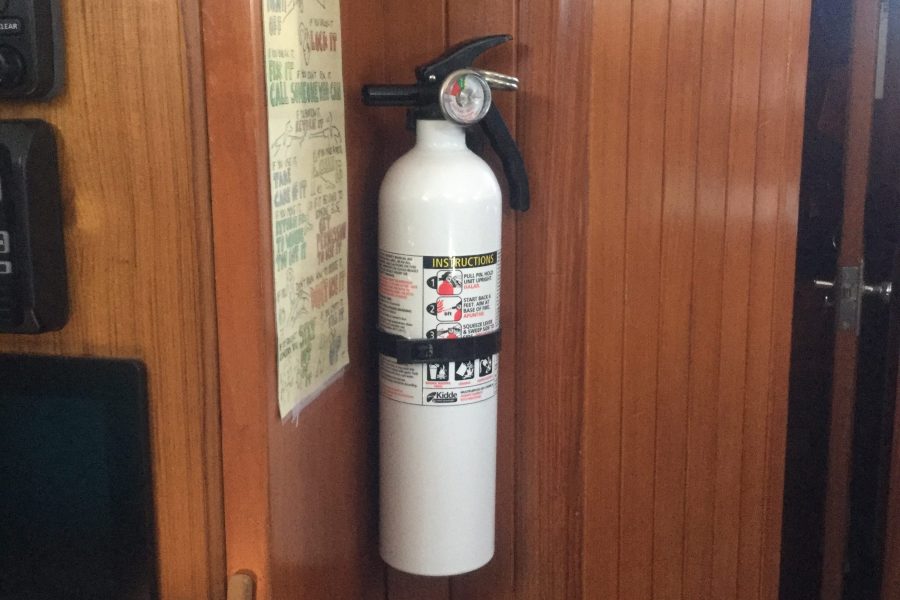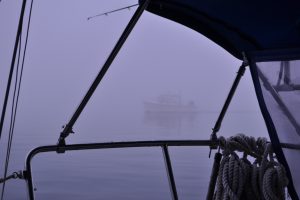FIRE IN THE ENGINE ROOM! A shout no one ever wants to here, FIRE, be it in the engine room, the galley, the electric panel or anywhere else on board will get your adrenaline going!
Regulations, be they from the Coast Guard, American Fire Protection Association, the American Yacht and Boat Council or, your insurance company are all designed to prevent an onboard fire and if one does occur to ensure you have the necessary tools to extinguish it.

An out of the way yet readily visible and easily accessed fire extinguisher
Which brings up the subject of Fire Extinguishers; I am not going to go into what type, size or how many you should have on board, most of us carry at least the number and type required by the Coast Guard for our vessels size, but in reality one must ask themselves are the minimum requirements enough?
While the Coast Guard addresses the number, size, and type of fire extinguishers we must carry there are no regulations from anyone specifying where they should be installed for quick use! This brings up a problem I have been observing, many boats have their fire extinguishers in the proper Coast Guard approved brackets but they are installed where they are hidden out of sight.

Onboard Malaya each cabin has at least one fire extinguisher in plain sight as well as one in the top of a cockpit locker. In all we have six units with one readily at hand anywhere we happen to be on the boat.
To be effective when a fire extinguisher is needed it must be used sooner rather than later! Fire once started doubles in size every couple of minutes growing exponentially as time goes on. So, it is vital your fire extinguishers be installed where they can be seen and that every crew member memorizes the location of every one.
As an example of how fast a fire can grow and consume a vessel, a few years ago off of Florida a 50’ sportfishing boat caught fire in the engine room. The crew was all on the flybridge and by the time the smoke was discovered the crew had just enough time to get into life jackets and jump overboard. The Captain and Mate climbed onto the top of the flybridge to release the life raft but were forced to jump overboard before they could finish their task. Fortunately, other boats in the area pulled everyone out of the water uninjured with the exception of burns suffered by the Captain and Mate. Total time from smoke discovery until the Captain and Mate on top of the flybridge were forced to abandon ship, less than 15 minutes!
In the case above the old adage, if there is smoke there is fire rings true and while if there is smoke there may not always be flames, the reality is, if there is smoke coming out of anywhere, a flaming fire itself is not far behind! I have had the misfortune to have two onboard fires on boats I was delivering. Both were electrical in nature and other than making a stink and giving everyone a good fright no harm was really done.
The first fire occurred when an alternator went bad and overheated, setting wiring and insulation around the engine room to smoldering. Shutting off the engine stopped the fire from actually breaking out but we didn’t know that at first as it took a few minutes for the smoke to clear. It was an anxious few minutes! The second fire occurred when a battery isolator overheated, melted and scorched the wood bulkhead it was mounted on. This fire was stopped by shutting down the electrical system and the engine. The worst aspect of this fire was the ungodly smell of burned electrical components in, unfortunately, a berthing space!
Fire extinguishers need to be readily available as once fire has started, time is of the essence! In the past several months as I was commissioning boats for the coming season I have seen fire extinguishers more often than not hidden in places like the back of a hanging locker, covered with foul weather gear, behind a settee back with the bracket mounted on the hull and the locker contents on top of the fire extinguisher, in the bottom of a deep cockpit locker where not only would someone have to climb down into a locker that more than likely has fire in it as it was open to the engine room but was also so full of gear one wouldn’t even know there was a fire extinguisher there. None of these locations are good. As I said, they need to be out in the open where one can find them readily!
It is also very important that you learn about the different types of fires and the proper way to extinguish them. Basically, there are three types which we can easily extinguish, Class A fires-Where A stands for ASH, so this fire involves things like paper and wood, stuff that leaves an Ash. Class B fires-Where B stands for BOIL, involving liquids like gas, oil, diesel. Class C fires-Where C stands for CURRENT, this is an electrical fire. There is a fourth type of fire a Class D fire, this type of fire involves burning metals such as magnesium, phosphorus and such, very few boaters would have the means to extinguish one of these fires as it requires special agents. When it comes to Class D fires my best advice, don’t play with your flares, especially below decks, if you accidentally set one off you won’t have a way to stop it from bu rning a hole thru your boat!
rning a hole thru your boat!
Your onboard fire extinguishers are labeled for the type of fire they were designed for, this is the ABC or BC classification you find on the label. Many, but not all, fire extinguishers sold to boaters are ABC type fire extinguishers.
AS IMPORTANT as knowing where your fire extinguishers are it is equally important to know how to use them and to know their capabilities and limitations. So, take a couple of units, set a controlled fire in a clear open space and practice!
Most of us carry what are known as “Dry Chemical” fire extinguishers that use a chemical powder to smother a fire. The vast majority of the Dry Chemical units carried aboard will last less than 10 seconds, not a very long time…So knowing how to use one is critical and the best way to learn is to actually use one and like I said practice.

Typical dry chemical type fire extinguishers most of us carry on board, this one is non-serviceable, having a plastic body and metal handle with a gauge.
A couple of things to be aware of when it comes to dry chemical fire extinguishers.
- Stored for long periods of time in the upright position the powder can cake in the bottom of the unit. Once or twice a year, turn the unit upside down and give it a hard rap on the bottom with your hand to loosen the powder. If you need to use it and nothing comes out, turn it upside down, rap it hard on a bulkhead and try again.
- As I said they only last 10 seconds, so have several handy
- Dry Chemical fire extinguishers make a mess, a fine powdery mess, so if you have an alternative to extinguish a fire such as a wet towel or baking soda on a stovetop grease fire or by shutting off the electrical system on an electrical fire do so.
- Be aware that using a dry chemical fire extinguisher on an electronics panel will ruin your electronics as it is very corrosive. There are agents for use on fires involving electronics but they are expensive and most of us don’t carry them.
- Fire extinguishers do need to be serviced or replaced. Units with a metal body and handle can be inspected, serviced and refilled if necessary. Units with a plastic body have an expiration date on them and need to be replaced when that date is reached or their gage says they are empty, they are not serviceable.
- If you use a unit for any reason it must be serviced or replaced as the valve seal once broken will continue to slowly leak and drain the unit of the gas that expels the powder.
As the worst fires we can have usually originate in the engine or machinery spaces it is important that an automatic system is installed in these areas with automatic engine shut down systems installed as well.
The best way to fight fire is to prevent it in the first place so being meticulous in your maintenance of all systems, keeping everything in the engine room clean, replacing hoses and wiring as they reach the end of their service life. It is also important that any electrical or engine work be done to ABYC and/or AFPA standards. Following their requirements may be more expensive but in the long run a lot less expensive than the alternative!
I also recommend that if you are going to be doing a lot of offshore sailing that you take the time and attend a fire fighting course at a Maritime Fire Academy, you can find them in major ports like Fort Lauderdale, Port Canaveral, Norfolk, and many other major shipping centers. The expense of a 2-5 day fire fighting course will be well worth your time.
Lastly, drill your crew, not only on how to use a fire extinguisher but can they from memory tell you or show you without hesitation where each one is located?







Leave a Reply
Your email is safe with us.